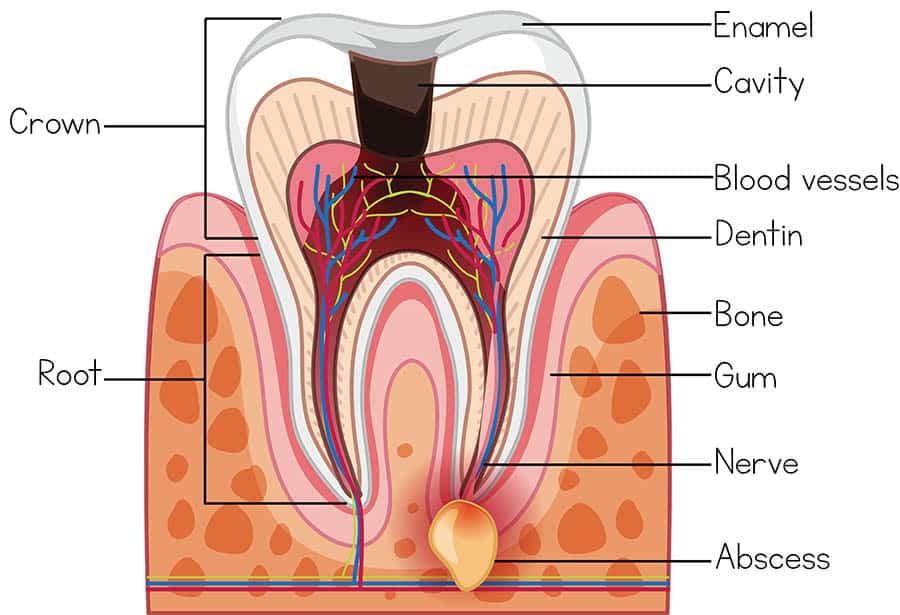Dr. Arthur A. Kezian | What to Do in a Dental Emergency?
____________________________________________________________________________________
By Arthur Kezian
How it All Starts:
Many people avoid going to the dentist on a regular basis because they say that they don’t have pain or because they don’t want to spend unnecessary money. This concept of thinking is wrong in the dental field. Why? Well, just because you are not in any pain does not mean everything is normal in your mouth. You may have a cavity or two, you may have early signs of gingivitis, or you may even have a cracked filling you might not know about. If things like this are left untreated for months, then they can develop into problems. That’s when you definitely will have pain … and, to add to the pain, you’ll be spending even more money to fix the issue than you would have if you had gone to your routine checkup where the issue could have been caught early on. When you’re in pain, you’re looking at a dental emergency appointment.
What is Considered a Dental Emergency?
An emergency can be any kind of trauma or injury to your tooth and is usually something serious. A dental emergency should never be ignored because it could lead to an increase in the risk of permanent damage as well as more vigorous work in the future (this includes more expenses as well).
Now, you might be thinking; what is considered a dental emergency anyways? Well, for starters, we’ve categorized some of the emergency treatments for you. They can be any of the following:
- Sudden or lingering toothaches
- Teeth that have chipped or have broken
- Teeth that have been knocked out or have fallen out
- Certain objects that may have lodged between your teeth
- A broken filling, broken crown, or broken veneer
- An infection in the mouth
- And, last but not least, damage to the mouth (soft-tissues).
What Should you do When Faced With any of These Emergencies?
Toothache Emergency:

If you’re having a toothache, rinse your mouth with warm salt water to clean the area out and floss near the area in case there is something lodged. If you have a swollen area, use a bag of ice or something from the freezer to apply a cold compress to the area and call your dentist right away.
“My Tooth Broke”, “My Tooth Chipped”:
If you notice a break or chip, save the piece in a small plastic bag and show your dentist. Again, rinse your mouth with a warm salt water solution. If there is also some bleeding, apply a compress using a gauze in the area for 10-15 minutes or until the blood is absorbed or until the bleeding has stopped. Call your dentist right away to see if he or she can fit you into their schedule for an emergency appointment.
Your Tooth Got Knocked Out:
If you can find the tooth, hold it by the biting surface and rinse the tooth with warm water. If the tooth has attached tissue on it, DO NOT pull it, tug it, or remove it. Don’t scrub it either. As hard as it may seem, try to place the tooth back. Make sure you are putting the tooth in the right direction. If, for some reason, you need to apply strength to push it back in, then don’t do it. You should never force the tooth back into the socket because you might do more harm than good. In this case, get your tooth and place it in a glass of milk. The American Association of Endodontists recommends using milk or other options to keep the tooth moist. If you don’t have milk on hand, place it in some water (not tap water) with a little pinch of salt mixed into it. Milk would be your first option though. Call your dentist ASAP to make an emergency appointment and if you weren’t able to put the tooth back in, then take the glass of milk or glass of salt water to your dentist. If the dentist can see you within the hour, then that would be the best chance for your tooth to be saved. Try not to let it go longer than an hour or so.
“There is something stuck in my tooth and I can’t get it out”
You would think that something like this wouldn’t necessarily be an emergency. But, sometimes certain objects can get jammed between the teeth or between the gums and you just can’t get them out. They can eventually start causing pain, inflammation, soreness of the gums, or even swelling. Take for example a popcorn kernel. If that gets stuck and you can’t get it out, it can irritate the area. To help with the situation, first try to floss the area carefully. Don’t cause any more damage by flossing aggressively. Also, brush your teeth because the bristles might help the object come out. Rinse with water to try to loosen the object. If all of these don’t do the trick, then call your dentist. Don’t use sharp object to poke at the area because you could harm your gums.
How to Deal with a Broken Filling:
We have heard people say to close the area temporarily using gum or some other adhesive material. We don’t recommend this. If you’re using gum, you have to make sure it’s completely sugarless because the sugar can cause sensitivity once it touches the now open space. Even if you’re using a sugarless gum, it’s still probably not the best idea to close the space because you don’t know what is going on inside. The best is to avoid chewing in that area to make sure food does not get trapped in the space. Clean the area gently using a warm salt-water rinse. Call your dentist as soon as you can to replace the filling.
How to Deal With a Broken Crown or Veneer:
If your crown or veneer comes off whole, as in, it is not broken or chipped, simply try to place the crown or veneer back on. With veneers, it will be a little trickier because there isn’t as much surface space as there is with a crown. If you can’t place the veneer back on, put it in a little bag, keep it safe, making sure it does not break and call your dentist. With your crown, try to place it back on. If you can, then do so and call your dentist right away. If for some reason you can’t get an appointment within the next few hours, you can get some dental cement from your local drugstore and use just a little bit of it inside the crown to keep it in place. The best though, would be to try to get an appointment as soon as you can. If the veneer or crown is broken, you can’t put it back on. Save the pieces (just in case your dentist needs to see them) and call your dentist right away! Most likely, you would need to make a new crown or veneer.
Abscess!

Simply put, an abscess is an infection. This infection usually occurs around the roots of teeth or between teeth and gums. An abscess is one of the most urgent emergency situations. If not treated, an abscess can infect other parts of the body. It is an infection that needs to be cleared out as soon as possible. Per the American Dental Association, some symptoms of an abscess can be:
- pain
- swelling
- redness in the gums
- bad or foul taste in your mouth
- fever
Call your dentist as soon as you notice any of these symptoms or if you notice a “pimple” on your gums. This can either be filled of puss or it may just be a swelling. In either case, call your emergency dentist immediately. In the meantime, cleanse your mouth with warm-salt water and take an Advil if the area is painful.
Damage to soft tissues:
We know what you’re thinking; what is considered soft tissue? Well, areas of the mouth like your tongue, your cheeks, your gums are all considered soft tissues. The inside of your lips contain soft tissue as well. Damage to any of these areas can result in scabs or bleeding. If bleeding starts, rinse your mouth with warm salt water to cleanse the area first, then, use a gauze to apply to the area that is bleeding. You can use some gentle force to help the blood get absorbed. If you don’t have gauze on hand, you can always use a tea bag. Just steep the tea bag for a little bit and then use it to apply gentle force in the area. Make sure the water you are putting the tea bag into is not too hot since you’ll need to place it in your mouth. Apply the gauze or tea bag for 10-15 minutes. In the meantime, call your dentist right away to schedule an emergency dental appointment.
If you have any questions regarding dental emergencies or what to do during them, please feel free to call our office. Our staff will be more than happy to help you with any of your questions. You can reach us at (323) 467-2777.
____________________________________________________________________________________
Dr. Arthur A. Kezian DDS
443 N. Larchmont Blvd.
Los Angeles, CA 90004
(323) 467-2777
____________________________________________________________________________________
References
- Cleveland Clinic, Dental Emergencies: What to Do – https://my.clevelandclinic.org/health/articles/11368–dental-emergencies-what-to-do
- Mouth Healthy, Dental Emergencies – https://www.mouthhealthy.org/en/dental-care-concerns/dental-emergencies
- Colgate, Do You Need Emergency Dental Care? – https://www.colgate.com/en-us/oral-health/conditions/dental-emergencies-and-sports-safety/do-you-need-emergency-dental-care-0113
- NCBI, Dental Emergencies – https://www.ncbi.nlm.nih.gov/pmc/articles/PMC1118447/
